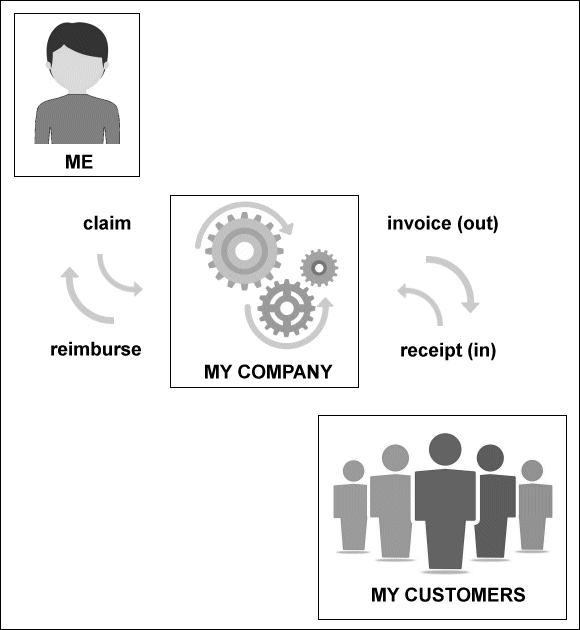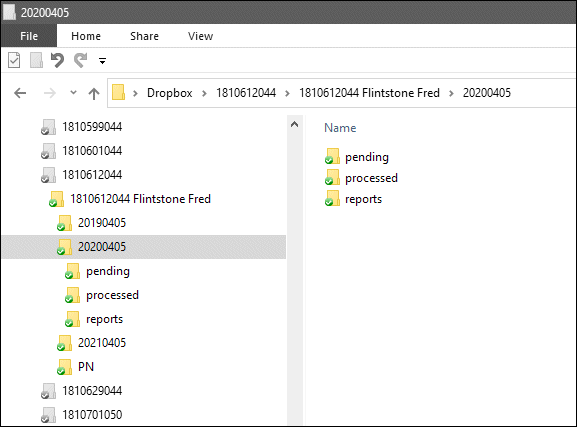You may be familiar with this process if you have ever been employed and had to submit an expense claim. As a director of your own limited company the process is the same, and it applies where directors and employees have used personal cash or a personal bank card to pay for a business cost.
It’s better to have all your suppliers invoice your company directly, and have the company pay them directly. If that could be done, you would never have to fill out a personal expense claim form.
Do not prepare employee expenses claims for items which the company has paid for directly from the company bank account or with the company credit card.
Keep the receipts for all of the things that you buy personally, on behalf of your business. Then once a month (or perhaps at some different interval) fill out a claim form and ask your company to reimburse you. If there is ever a records inspection by the tax office, they will want to see the claim forms with supporting receipts, and they will also check that the reimbursements on the company bank statements match the amounts claimed on the expense forms.
Motor expenses
Mileage on business journeys should be claimed at the HMRC approved rate. These have been the same since 6 Apr 2011.
• 45p per mile – first 10,000 miles per year
• 25p per mile – additional miles
No other motoring costs are to be claimed. The FPCS rates from HMRC are calculated by the AA so as to cover all the conceivable running costs of having a car! That means that you have to keep a log of all of your business journeys in your own car.
Foreign Currencies
Separate out any expense receipts which are in foreign currencies and prepare an individual claim form in each separate currency. That way the sub-totals do not end up with mixed currencies.
Non-VAT Registered Businesses
Use two forms, one form for mileage and just one form for all other business expenses. Separate the receipts by category and claim back the gross amount including VAT. Use the non-VAT form in the samples below, and just put all the figures on that.
VAT Registered Businesses
Separate your personal expense items according to whether they have VAT on them or not. VAT receipts for motor fuel belong in another separate pile. VAT on fuel can be reclaimed, but only to the extent that it is vouched for on actual VAT receipts.
Use three forms, one form for mileage and two separate forms covering expenses with VAT and expenses without VAT. As a director/employee you are claiming back all of the gross amounts including all the VAT. The bookkeeper needs to know which items include VAT and which ones don’t. That’s why there are three different forms for a VAT registered business.
Book keeping and sample forms
If you are doing your own book keeping, use the totals in each column and post them into your software. Download these sample forms (MS Excel) if that helps:
• Mileage Claim
• Non-VAT Expenses
• VAT Expenses
Expenses in the first month or two
Normally a new business, will lead to cash expenses which you want to reclaim, before you have any funds to pay them. There are two ways to handle this dilemma.
• Wait until the business can afford to make the reimbursement.
• Introduce working capital (use a round sum) into the business, and then reimburse yourself!
Over the course of the financial year movements in capital introduced and capital withdrawn accumulate and may be shown in the annual accounts as a loan from the director to the company. Take care, because capital movements can sometimes work the other way. If you take too much capital out of the company, the loan is the other way around and there can be adverse tax consequences.
Recharging Costs to customers
Company’s do not claim from customers, they invoice.
Company’s are not reimbursed by customers, the customer pays the bill. Your company has a receipt in the bank account.
Reserve the expressions claim and reimburse for activities that occur between you (or your staff) and your company.
If your company recharges costs to a customer it is done on an invoice. The amounts recharged are usually liable to VAT. See the Disbursement or Expense report for more details of what may and may not be liable to VAT.

In a legal sense transactions between you and your company, and transactions between your company and your customers are entirely different obligations.
The terminology matters. This is one of the few situations where all accountants, bookkeepers and VAT officers need you to understand this concept fully.
Staff claim and staff are reimbursed.
Company’s do not claim from customers, they invoice.
Company’s are not reimbursed by customers, they have a receipt.
The mechanics of processing an expenses claim
It’s your business, and it’s up to you how you run it. We are just the accountants that do the bookkeeping, the VAT returns, the year end accounts and tax returns. We do not run your internal systems for you. Ordinarily we expect you and your staff to prepare your claims on a regular basis, not once per year, and definitely not one week before the Companies House accounts deadline.
At Proactive we have this system, our staff can submit one claim per month, which is due in by the last day of the month and is then paid by the 14th of the following month. If they miss a month end deadline then they have to wait a further month for any claim to be accepted and reimbursed.
Your claim is subject to the approval of one of your own internal staff members who will scrutinise it with care. If approved, one of your internal staff will then invoke the mechanics of the reimbursement, normally by doing a bank transfer. Do not wait for the next VAT quarter to end, do not wait for Proactive to check things, it’s not our job to micro manage your business for you. However, to ensure that the accounts correctly reflect what you do, we do require copies of all personal expenses claims from all your staff. If our checks identify areas of concern we will discuss the problem and the remedies which are open to you.
Finally, if you are the only person in your business, you still have to follow this process. And to do this task with some rigour. Imagine you are wearing two hats, the one who does the claim, and the one who approves the claim. To see what’s allowable and what isn’t, please have a look at The Senior Manager Test on this web site.

